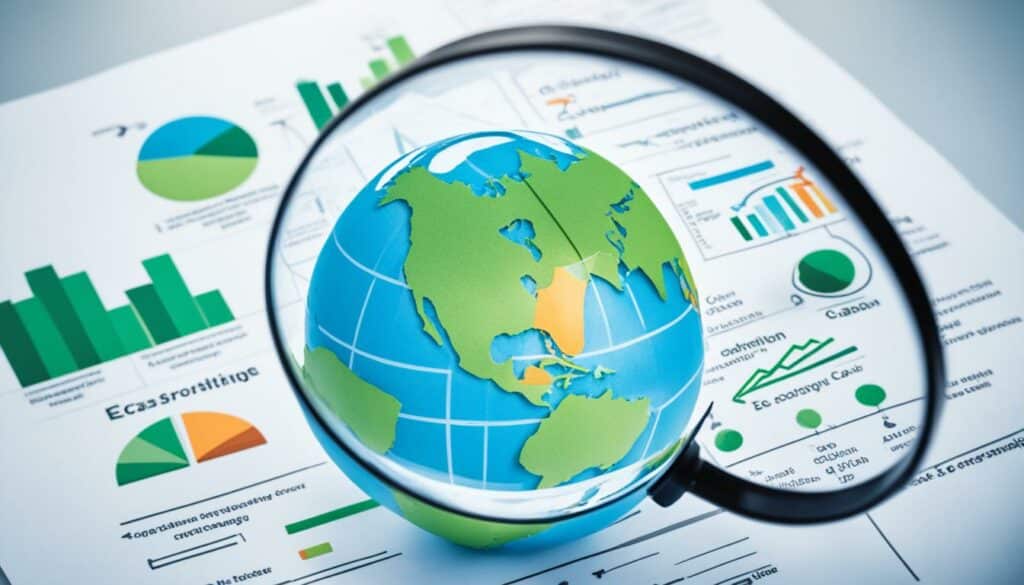Menu

Did you know turning down your water heater to 120˚F can save a lot of energy? You won’t notice any change in your daily life. This simple step is just one of many that can reduce your carbon footprint. Realising my environmental impact, I look into carbon footprint research, sustainability assessment, and ecological footprint evaluation.
By examining how I use energy and make transport choices, I aim to live more sustainably. This includes small changes to help fight climate change.
Knowing about a carbon footprint helps us see our environmental impact. It’s the total greenhouse gases that come from what we produce and use. People, companies, and even countries can measure their impact this way. It helps us see the big picture of our greenhouse gas output.
A carbon footprint shows how much greenhouse gas we make through what we do. A U.S. household typically emits 48 metric tons of CO₂e each year. This includes things like how we use energy, our travel, and even what we eat. Notably, what we eat makes up a big part of our impact. By looking closely, we can find out what activities create the most emissions.
Our daily actions add up to create our carbon footprint. For example, in 2021, home electricity use in the U.S. put out 578.3 Mt CO2e. This was about 9.1% of the country’s total. The cars we drive also matter. In 2021, cars and light trucks in the U.S. contributed 1.05 billion metric tons of CO2e. This was around 16.5% of all U.S. greenhouse gases.
Food choices significantly affect our impact, too. Livestock like beef cattle emit a lot of methane. In 2021, they put out 195 million metric tons of CO2e, and beef cattle were responsible for 71% of that. Making simple changes, like eating vegetarian meals once a week, can lower your carbon footprint.
Looking into our impact lets us find the most important areas where we can do better. For example, using less energy by turning off devices standby mode can save money and reduce energy use. This could lower an average U.S. household’s bill by $100 a year. It also cuts down on 5-10% of the energy used at home.
By understanding the sources of our carbon emissions, we can make smarter choices. These decisions can help us all reduce our global impact. This is key for our planet’s health.
Reducing our carbon footprint is vital, affecting the path of climate change. When we all pitch in, each person’s action adds up to big environmental wins worldwide. Lowering emissions helps urgently across sectors, highlighting how crucial our collective efforts are.

Minimising emissions directly fights climate change. Research shows that reducing global emissions significantly over the next 50 years can stop about 4.5 million early deaths. This effort also cuts down on hospital visits, lost work days, dementia cases, and crop losses. By 2070, heat in the U.S. could outdo air pollution in causing deaths if climate goals aren’t met.
In the U.S., fewer people are expected to die due to pollution if action is taken now. Yet, climate-related deaths could still increase by 2030 unless we meet the 1.5°C warming target.
The benefits of cutting emissions last long. Moving to a net-zero carbon economy is worth it financially within ten years. These efforts lead to cleaner air, better public health, and a more balanced ecosystem.
About two-thirds of these benefits could happen, even if only the U.S. reduced its emissions. Most consumers want to see carbon labels on products, showing strong support for decreasing footprints.
The average American’s carbon footprint is way higher than the world’s average. We can lower this by tracking and reducing emissions at all levels. It’s key to use sustainable methods to protect the Earth for those to come.
Researching our carbon footprint is key to protecting the environment. It’s about looking at the gases we make in our daily lives. Then, we use this information to choose ways to live more sustainably.
We have lots of tools to measure our carbon footprint. These include online calculators for personal use and complex systems for companies. The latter, like WM’s system, use official data for a deep look at emissions.
This method looks at all the emissions. It includes those from vehicles and even those related to stuff we buy. By doing this, we get a clear picture of our impact.
Knowing what our data means is important. It helps us find the big problems and the best ways to fix them. For businesses, a detailed plan helps keep an eye on their emissions.
Once we understand the data, we have to make sure it’s right. Getting it checked by others, like WM does, is crucial. This way, everyone can trust it. Then, they can take actions that really help meet our green goals.
Bringing carbon footprint research into our daily routines can be life-changing. It shows us how to make real personal changes. Also, it helps nudge policy and planning in more green directions. The average U.S. household creates 48 metric tons of CO₂e yearly. This shows why detailed environmental impact analysis and ecological footprint evaluation are crucial for big cuts.

Figuring out our carbon footprint is key to changing how we live. Food choices matter a lot because they make up about 30% of our carbon footprint. Local, plant-based diets are a great choice. They cut food emissions significantly. Also, our home electric use creates a lot of CO₂e. By using energy-saving machines and LED lights, you could save over $200 a year.
| Category | Impact | Suggested Action |
|---|---|---|
| Food | 10-30% of footprint | Shift to local, plant-based diets |
| Electricity | 9.1% of U.S. total | Adopt energy-efficient appliances and lighting |
| Vehicles | 16.5% of U.S. GHG emissions | Use public transport, carpool, switch to electric vehicles |
Understanding our ecological footprint is critical for making good policies. For example, shifting from old light bulbs to LEDs cuts costs and emissions. On a wider scope, covering 80% of U.S. commercial roofs with solar materials would cut an enormous amount of CO₂. It’s as good as having 34 coal power plants stop for a year. Such clever policies rely on solid environmental impact analysis. They guide us towards better, green practices.
Creating a sustainable home is good for the planet and your wallet. Use energy-efficient appliances, save water, and recycle well. These steps are key.
Choosing efficient household appliances cuts energy use. Look for the ENERGY STAR label. It means less electricity will be used. In 2021, homes’ electricity usage in the U.S. caused a big portion of the nation’s CO2 emissions. Making small changes, like checking your thermostat or getting an energy audit, can save a lot of energy. Space heating and cooling use up nearly half of a home’s energy.
Conserving water is vital for a green home. Set your water heating lower and use low-flow showerheads. These steps save water and energy, cutting your home’s carbon footprint. Households play a big part in improving the planet’s health.
Good recycling reduces waste and lowers carbon footprints. Buy less to reduce waste and sort your recyclables well. This means less waste ends up in landfills. Food production causes most of the emissions from this sector. Managing waste better can help cut these emissions.
Changing what I eat wisely can really help cut down on carbon emissions. A recent study showed that by swapping certain foods, I could reduce my carbon footprint by 35%. This is good for the planet and for my health.
Eating more plants can make a big difference. For instance, eating less beef helps lower greenhouse gas emissions. By choosing chicken, turkey, or plant-based foods instead, I can bring down my carbon footprint. One study looked at what 7,700 Americans ate and found this switch could reduce their food’s carbon footprint by 35%.

Little changes in what I eat can do a lot for our planet. It was interesting to find that giving children almond or soy milk instead of cow’s milk can reduce emissions. Replacing beef with turkey in meals like burritos and pastas also cuts a lot of emissions.
These findings highlight how small food changes can make big positive differences. They improve both our diets and our planet.
These swaps started out aimed at lessening climate impact. But they’ve also turned out to be healthier. By knowing which foods have more climate impact, I can make choices that are better for me and the planet.
Working together, all Americans can make a big change. If people choose lower-carbon foods, we could reduce our country’s dietary carbon footprint by over 35%. This shows how important our food choices are for the planet and for our own carbon footprints.
Reducing how much energy we use is key to cutting our carbon footprints. We should push for more renewable energy and really look at how we use energy at home. This can help a lot towards making our world more sustainable. Doing checks on our home energy use and making our houses better insulated are big steps. They can save a lot of energy and cut down on harmful gases we put in the air.
Sources like sunlight and wind power are crucial for the planet’s health. When we switch to these, we lower the bad effects we have on the environment. We also reduce how much we need oil and gas. Choosing to use green energy through special plans is a smart and meaningful way to care for our planet.
Checking our home’s energy use gives us good info on where we can do better. For example, gadgets on standby can use quite a bit of energy, costing us money. This can total up to $100 a year for the average family. Making our homes better insulated can use much less energy. It can shrink the yearly carbon footprint of a U.S. family, which is now 48 metric tons CO₂e. Better insulation means our heating and cooling work better, which is good for the environment.
Transport has a big effect on our carbon footprint. We can make a real difference by changing how we travel.
Choosing public transport and cycling is great for the environment. These methods produce less pollution than cars. They also cut down on individual car use, which means less pollution.
You can even save a lot of money, more than $9,738 a year, by using public transport instead of driving.
Strong public transport systems in communities help a lot too. They can reduce the country’s carbon emissions by 37 million metric tons each year. Plus, sharing a car with someone else takes one car off the road, lowering emissions more.
Switching to electric or fuel-efficient cars can significantly reduce pollution. These cars save a lot on fuel costs over time. For example, a car that gets 30 miles per gallon saves about $3,000 compared to a 20-mile car. Better fuel economy could save Americans a massive 1.5 million barrels of fuel every day.
For unavoidable trips, buying carbon offsets can help tackle the damage. Car-share programmes also reduce the number of cars, which means less fuel burned. Simple things like turning off the engine when parked and keeping tyres fully inflated cut down on CO2 emissions too.
Keeping tyres inflated properly can save about 275 pounds of CO2 each year.
In today’s world, how we shop affects the environment a lot. Being mindful about what we buy and choosing wisely is crucial. It helps fight climate change and makes a difference.
It’s better to pick products that last long than those that don’t. Fast fashion leads to more waste. For example, during the holiday season, people in the U.S. create a lot of extra trash. This adds up to a huge amount of waste.
Buying durable items helps. It means less trash and fewer disposable things thrown away.
Going for second-hand or vintage items is smart too. Each year, we send out so many Christmas cards. If we buy second-hand, we save these resources. It also stops more waste from being made.
Buying from eco-friendly companies is good for the planet. Some big oil companies are major polluters. But, by choosing brands that are honest about their environmental impact, we help in a big way.
The rich in the world create most of the pollution. This puts a lot of strain on the environment. Choosing eco-friendly products can help balance this out.
Avoiding companies that waste a lot, like with ribbon, is wise. This moves the market towards more eco-friendly choices. It supports the fight against climate change and lower emissions.
Picking the right things to buy can really make a difference. It helps fight climate change and encourages businesses to be more sustainable. I believe in the power of my choices.
Getting involved in community and advocacy work really boosts my impact on climate and green practices. I take part in local groups for climate action and help with wider policies. This way, I get to shape how my area looks environmentally in the future.
Joining a local climate action group lets me work right on measuring and improving sustainability. Since 1993, over 800 cities have got help from a big campaign. This work helps us make better carbon offset plans and check on climate change more effectively.

In my area, joining community projects has been really effective. For example, a project in Davis, California, changed how people there used energy, cutting their carbon prints. Even so, keeping people involved and finding enough support are real issues. We need these groups to work well.
Engaging with policy is a key part of my climate work too. Back in 2005, over 500 U.S. mayors agreed to reduce greenhouse gases. I support these policies by reaching out to local leaders and joining meetings. This pushes for measurement of green practices and carbon offset plans.
Studies show that if we offer the right incentives and reach out well, more people will join in. In Fresno, a survey found that those linked to organization were eager to help with climate change. So, by supporting policies that help people get involved, we can do more to reduce carbon footprints.
| Statistic | Details |
|---|---|
| Cities Assisted | 800+ cities have received assistance since 1993 |
| Mayor’s Climate Protection Agreement | 500+ U.S. mayors encouraged local climate action plans since 2005 |
| Community Participation in Davis | Positive outcomes in changing energy behaviours |
| Willingness to Attend Climate Meetings | One-third of Fresno voters were willing to attend |
Technological changes have become key in reducing my carbon footprint. They help cut down greenhouse gas emissions in my day-to-day life. This includes smart home tech and energy management systems.
Smart home gadgets are essential for a green home. They manage energy for you, reducing waste. Smart thermostats, for example, adjust your home’s temperature based on when you use it most. This is proven to lower emissions.
Energy management systems are also vital. They give live feedback on your energy use. This lets you find and fix areas of waste, boosting your home’s efficiency. Studies show this can make a big difference in your overall emissions.
Using these technologies not only cuts down on toxic emissions. It also creates a home that’s efficient and ready for the future. Tech is a crucial part of improving how we manage our carbon footprint.
| Technological Solution | Environmental Benefit | Statistical Insight |
|---|---|---|
| Smart Thermostats | Reduces energy waste | Optimising home temperature settings can cut emissions by up to 15% |
| Energy Management Systems | Monitors and reduces unnecessary energy use | Real-time data can prevent up to 20% energy waste |
Businesses are key in lessening carbon emissions. They should do carbon footprint research. This helps them keep track of their environmental impact and reduce it. By taking on corporate responsibility and measuring sustainability, they can greatly help with ecological footprint evaluation.

Corporate responsibility means looking beyond profits to how a business affects the environment. Studies show that carbon emissions are big factors in global crises like extreme weather and high sea levels. Companies should aim for sustainability to fight these issues. They can do this by recycling well, using less energy, and choosing sustainable energy sources.
Going green is important for companies wanting to cut their carbon footprint. They need to review their environmental impact closely in their plans. This means not just doing things alone, but also working with others and learning from research.
By using research methods, like bibliometrics and knowledge graphs, they can see what works best from 1992 to 2019. They can find effective ways and build partnerships. For example, supporting clean energy projects and using energy-saving appliances shows not just care for the environment but also meets the need for sustainability.
Ultimately, businesses help a lot by measuring sustainability and going green. This move is good for meeting their sustainability goals and is appreciated by customers who care about the planet.
Looking back at my carbon footprint research, I see how important our choices are. I now understand that what I do every day affects the whole world. By checking sustainability and my ecological footprint, I know I’m doing my part to help stop climate change.
But, measuring carbon footprints isn’t perfect yet, especially with freight transport. Many tools only look at a company’s greenhouse gas emissions, forgetting about the whole supply chain. To fix this, a new European approach looks at all greenhouse gases and focuses on the energy used in transport. This new way is a big step towards better, more accurate measurements.
A workshop at MIT also taught me about using the Analytic Hierarchy Process to pick the best tools. It showed that tools should be deep, wide, precise, fair, and easy to check. We need future tools that work the same for all kinds of transport. They should also show how well each carrier is doing in being eco-friendly. Having a range of simple to complex tools will make it easier for everyone to understand and cut down on greenhouse gas emissions.
Learning about the carbon footprint in farming has also been eye-opening. It shows the value of using less harmful methods and growing different crops. Adopting these farming strategies into my life, and promoting policies that help the environment, is my way of making a difference. By staying committed to learning and acting, we all have the power to lower our carbon footprints and protect our planet.
A carbon footprint shows how much we add greenhouse gases. This comes from what we make and buy. It links to what each person, company, or country does.
Things you do every day like driving, what you eat, and how you use energy add to your carbon footprint. Knowing this helps you make better choices. You can lower how much you add to climate change.
Lowering your carbon footprint slows climate change. If everyone does their bit, we can really cut down on harmful greenhouse gases. This will help keep the planet livable for the future.
Bringing down your carbon footprint does a lot of good. It fights climate change, supports green living, and ensures a better world for those coming next.
You can find online tools that help measure how all parts of your life affect the environment. These look at your travel, food, and energy use.
Once you know your carbon footprint, you can see what changes would make the biggest difference. This is about working towards making your life more sustainable.
Changing how you live can lower your carbon emissions. This includes using more renewable energy, eating differently, and creating less waste.
Knowing your carbon footprint can help shape policies for a more sustainable lifestyle. This pushes for decisions that help our planet and encourage smart environmental choices.
Look for appliances with the ENERGY STAR label. They use less power, which helps you cut down on your carbon footprint.
Using less water can also cut down on your carbon footprint. Techniques include installing low-flow showerheads and turning down water heaters. This saves water while also saving energy.
Recycling is key to reducing waste and saving resources. It greatly cuts down on how much your lifestyle impacts the environment.
Eating more plants is better for the environment. It uses fewer resources and creates less harmful gas. This includes choosing foods like vegetables over foods like beef.
Swapping high-emission foods for others can lower your carbon footprint. This change in your diet can also improve your health.
Using wind or solar for your energy means less fossil fuel. This leads to fewer harmful emissions in the atmosphere.
Audits help find where you’re using more energy than you need. Better insulation keeps your home at the right temperature without using extra power. Both lead to using less energy and having a smaller carbon footprint.
Taking buses, trains, or riding a bike lessens your impact on the environment. It’s an important step in reducing your personal carbon footprint.
Electric cars are cleaner than traditional cars. They cut down on the harmful gases that contribute to climate change.
Go by bus or train when you can. If you must fly, you can buy carbon offsets to balance out your journey’s environmental impact. This helps counter your carbon footprint.
Picking well-made items that last helps the planet. It means less waste and less energy spent on making new things. This is good for the environment.
When you choose brands that care for the planet, you support better production. It helps in lowering the overall harm to the environment.
Being part of a climate action group in your area is a way to make a real difference. It focuses on reducing carbon footprints and promoting a greener life.
By working on policies, we can make big steps towards saving the earth. This involves pushing for laws that protect the environment better.
Smart devices help us use energy smarter at home. They stop us from using energy when we don’t really need to. This is great for the planet.
These systems watch and control how we use energy. They help us use less energy in total, which is kinder to the environment.
Big companies can help by using methods that are better for the planet. This way, they reduce harm and meet eco-friendly goals.
Companies can make a difference by recycling more, being energy efficient, and using clean energy. This cuts down on their own carbon footprint.